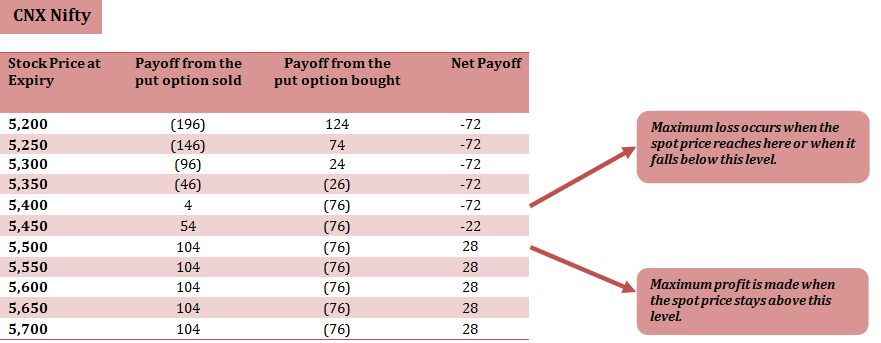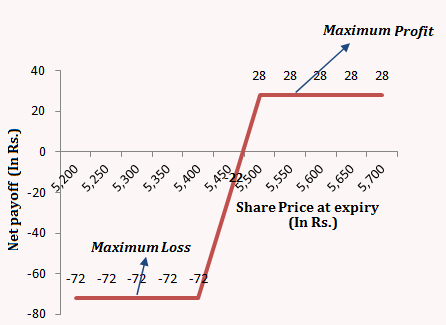When to use: Bull Put Spread strategy is used when the investor believes that the stock/index price will rise in future or at best it will trade in a tight range, i.e. the investor is bullish on the stock/index.
How it works: In a Bull Put Spread strategy the investor sells one put options and buys another, both of the same underlying stock and same expiry date. Typically, the put option sold will have a strike price closer to the spot price compared to the put option purchased. This will result in an immediate income in the form of net premium collected by the trader.
The trader implementing this strategy is hopeful that the price of the stock/index will remain above the strike price of the put option sold and he will be able to retain the net premium. Note that the put option purchased (i.e. the one with the lower strike) increases the cost of the trade by reducing the amount of premium collected on the put option sold, but at the same time, it acts as an insurance against a sharp fall in the stock/index level.
For example: On 5th September 2013, when the Nifty was trading at Rs. 5593 level (spot), you sell a put option with a strike price of Rs. 5,500 at a premium of Rs. 104 and simultaneously buy a put option with a strike price of Rs. 5,400 at a premium of Rs. 76. Both calls expiring on 26th September 2013. The net premium collected by the trader on this trade is Rs. 28 (i.e. Rs. 104 – Rs. 76).
Risk/Reward: In the Bull Put Spread strategy, maximum loss occurs when the spot price falls to (or below) the level of the strike price of the put option bought, (i.e. your maximum risk will be to the extent of the difference between the between the two strike prices minus the net premium received). Maximum profit will be limited to the net premium collected and will be made if the spot price closes at or above the strike price of the put option sold (i.e. Rs. 5,500 in our example).
The table below will clarify the net payoff of the Bull Put Spread Strategy by assuming different spot prices on expiry:
(click to enlarge)
How to use the Bull Put Spread Option Strategy Excel calculator
Just enter your expected spot price on expiry, option strike price and the amount of premium, to estimate your net pay-off from the Bull Put Spread Option Strategy.
Note: The example and calculations are based assuming a single share though in reality options are based on lots of many shares. For example Nifty’s option contract is for 50 shares. Accordingly the net premium received will be Rs. 1,400.00 for 2 lots (i.e. 28*50) in our example.
Also Note: Unlike the buyer of an option who only pays the premium to buy the option, the seller of an option must deposit a margin amount with the exchange. This is because he takes an unlimited risk as the stock price may rise to any level. In case the price rises sharply above the strike price, the exchange utilises the margin amount to make good the profit which the option buyer makes. The amount of margin is decided by the exchange and it typically ranges from 15 % to 60 % based on the volatility in the underlying stock and market conditions. In the above example, as a seller of call option, you will have to deposit a margin of Rs. 22,000 (i.e. Strike price * Lot size * 8%) for selling/writing a lot of Nifty’s put option. Note that the total value of your outstanding position in this case will be Rs. 2,75,000 (i.e. strike price * lot size).




Why is the payoff from the put immediately -196?